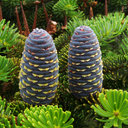Chemical composition and biological activity of Abies alba and A. koreana seed and cone essential oils and characterization of their seed hydrolates.
Mots clés
Abstrait
The chemical composition, including the enantiomeric excess of the main terpenes, the antimicrobial and antiradical activities, as well as the cytotoxicity of Abies alba and A. koreana seed and cone essential oils were investigated. Additionally, their seed hydrolates were characterized. In the examined oils and hydrolates, a total of 174 compounds were identified, which comprised 95.6-99.9% of the volatiles. The essential oils were mainly composed of monoterpene hydrocarbons, whereas the composition of the hydrolates, differing from the seed oils of the corresponding fir species, consisted mainly of oxygenated derivatives of sesquiterpenes. The seed and cone essential oils of both firs exhibited DPPH-radical-scavenging properties and low antibacterial activity against the bacterial strains tested. Moreover, they evoked only low cytotoxicity towards normal fibroblasts and the two cancer cell lines MCF-7 and MDA-MBA-231. At concentrations up to 50 μg/ml, all essential oils were safe in relation to normal fibroblasts. Although they induced cytotoxicity towards the cancer cells at concentrations slightly lower than those required for the inhibition of fibroblast proliferation, their influence on cancer cells was weak, with IC50 values similar to those observed towards normal fibroblasts.



